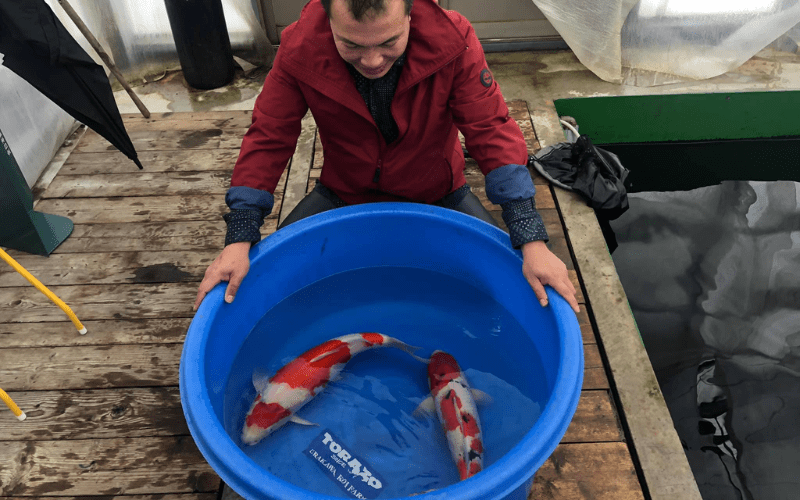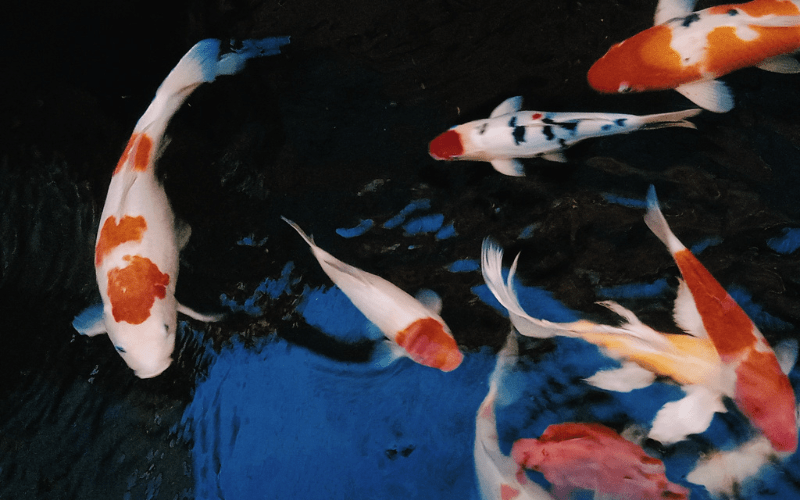Transporting large koi fish is a delicate process that requires careful planning and proper handling. Koi fish are prized for their beauty, and as they grow, their size presents unique challenges during transport. Whether you’re moving them to a new pond, taking them to a koi show, or relocating to a new home, ensuring your koi arrive safely and stress-free is critical for their health and well-being.
At Torii Koi And Pond, we understand how much care goes into maintaining the health of your koi fish, and this includes moving them safely from one location to another. In this blog post, we will walk you through everything you need to know about transporting large koi fish safely, from preparation to post-transport care.
Why Is Proper Koi Fish Transport Important?
Transporting large koi fish is not the same as moving smaller species. Due to their size, koi fish are more prone to injury and stress during the process. Poor handling or improper conditions can lead to health issues, injury, or even death.
Koi are sensitive to environmental changes, and any disruption during transport can cause a high level of stress. Maintaining stable water conditions, minimizing handling, and ensuring a comfortable transport environment are essential for a successful move. By following proper koi transportation techniques, you can avoid common issues and protect the health of your koi during the journey.
Preparing to Transport Large Koi Fish
Before transporting your koi fish, preparation is key. Torii Koi And Pond recommends using the right equipment and ensuring that both the koi and their transport environment are ready.
1. The Right Equipment
- Transport Bags: Use large, durable bags that are specifically designed for koi transportation. These bags should be thick enough to prevent tears or leaks and large enough to give the koi room to breathe.
- Oxygen Supply: Adding oxygen to the transport bag is vital. You can either use an oxygen tank or oxygen tablets to ensure the water remains oxygenated for the duration of the journey.
- Koi Socks and Nets: These tools allow you to move the koi from the pond to the transport bag with minimal stress. Koi socks are especially useful for gently guiding the fish into the bag without causing harm.
2. Preparing the Koi
- Fasting: Fast your koi for at least 24 hours before transport. This reduces waste production during the journey and helps maintain water quality inside the transport bag.
- Handling with Care: Always handle koi with wet hands or gloves to protect their slime coat, which serves as a natural barrier against infections.
- Water Temperature: Make sure the water in the transport bag is at the same temperature as the pond water. Sudden temperature changes can shock the koi and increase stress levels.
Step-by-Step Guide to Transporting Large Koi Fish
Step 1: Catching and Handling the Koi
Catching large koi fish requires patience and the right technique. Use a koi sock or net to gently guide the fish into the transport bag. Avoid lifting the koi out of the water too quickly, as this can cause injury. Torii Koi And Pond suggests using a soft net and supporting the fish with both hands when lifting it.
Step 2: Packing the Koi for Transport
Once the koi is in the transport bag, add fresh, clean pond water and enough oxygen to last for the duration of the trip. Seal the bag securely with rubber bands to prevent leaks. It’s best to double-bag for extra protection. Place the sealed bags in a cooler or transport tank to maintain temperature control during the trip.
Step 3: Transporting the Koi Safely
During transport, keep the koi’s environment stable. The bag should remain upright, and you should avoid sudden movements or drastic changes in temperature. If traveling long distances, make sure to monitor the fish for signs of stress, such as rapid gill movement or erratic swimming. Torii Koi And Pond recommends keeping trips as short as possible to minimize stress on the fish.
Step 4: Acclimating and Releasing the Koi
When you reach your destination, acclimate your koi fish slowly. Place the transport bag in the new pond for 15-20 minutes to equalize the temperature. Gradually introduce the koi to the new water by opening the bag and allowing some pond water to mix with the transport water. After a few minutes, gently release the fish into the pond.
Common Mistakes To Avoid During Transport Large Koi Fish
While transporting large koi fish may seem straightforward, there are a few common mistakes that can harm the fish. Here are some key mistakes to avoid:
- Using Too Small Bags: If the koi doesn’t have enough room to move, it can become stressed and injured during transport.
- Skipping Oxygenation: Lack of oxygen can quickly lead to dangerous conditions for the koi. Always ensure the transport water is well-oxygenated.
- Temperature Shock: Failing to match the water temperature in the transport bag with the pond water can lead to temperature shock, which is harmful to koi.
Why Choose Professional Koi Transport Services?
If you are unsure about handling koi fish transport on your own, consider hiring a professional service. Torii Koi And Pond offers specialized koi transportation services with oxygenated tanks, temperature control, and experienced handlers. These services can reduce the risk of stress and injury, ensuring your koi arrive safely.
Key Points on Transporting Large Koi Fish Safely
- Always fast koi for 24 hours before transport to reduce waste in the water.
- Use thick, double transport bags filled with oxygen for long trips.
- Maintain stable water temperature throughout the journey to avoid shocking the fish.
- Handle koi carefully using soft nets and koi socks to prevent injury.
- Acclimate the koi to their new environment slowly by allowing the transport bag to float in the pond first.
FAQs
How long can koi fish stay in a transport bag?
Koi can stay in a properly oxygenated transport bag for 6 to 8 hours. However, it’s best to minimize transport time to reduce stress on the fish.
What size bags should I use for large koi?
Choose bags that are at least 36 inches in length for larger koi. This provides ample room for the fish to move and ensures better oxygenation.
Can I transport more than one koi fish in the same bag?
It’s recommended to transport each large koi in its bag to prevent overcrowding and reduce the risk of injury.
How can I reduce stress during transport?
Adding a stress coat or sedative to the transport of water can help reduce stress. Keeping the trip short and maintaining stable water conditions are also crucial.
What should I do if my koi seems stressed after transport?
Monitor your koi for signs of stress, such as rapid gill movement or erratic swimming. If these symptoms persist, contact a koi health specialist.
Conclusion
Transporting large koi fish safely requires the right preparation, equipment, and handling. By following the steps outlined in this guide, you can ensure a smooth and stress-free journey for your koi. If you’re looking for expert assistance, Torii Koi And Pond offers professional koi transport services to guarantee the health and safety of your prized fish.







